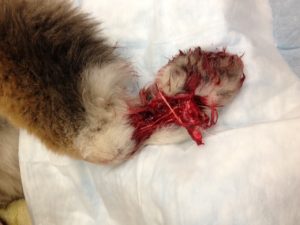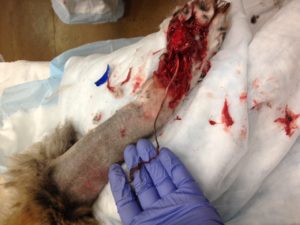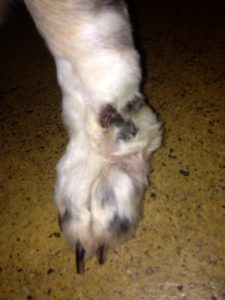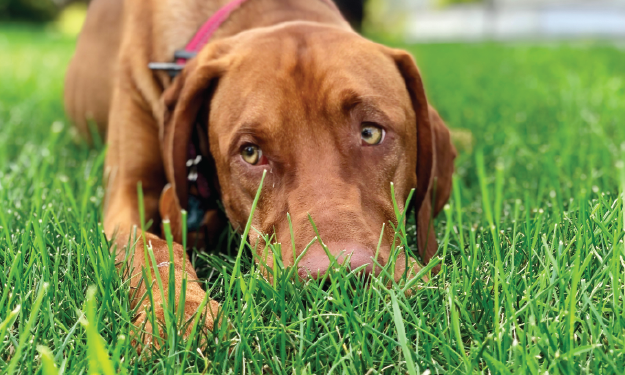 I evaluated Akiko the morning after she arrived through our ER. Akiko had a severe wound on the distal aspect of the left thoracic limb. The wound encompassed the entire dorsal metacarpal surface with exposure of the extensor tendons. There was a comminuted grade 3 open fracture of the 5th metacarpal bone. The wound extended to just proximal to the metacarpal pad. There was no overt instability of the carpus and manus as a whole. A dorsopalmar radiograph was obtained and delineated the MC5 fracture but no other overt bony injuries. There was conscious sensation in the digits. I met with Akiko’s owners and discussed treatment options. They were interested in salvaging her limb if at all possible. The challenges associated with ensuring tissue health followed by obtaining closure of the wound were discussed, but limb salvage was considered feasible since enough of the weight bearing portion of the paw was not affected. We discussed that there would be an initial phase of open wound management to allow granulation tissue formation (ensuring tissue health and greatly reducing the risk of infection), followed by reconstructive procedure(s) to achieve a functional result, as the defect was considered too large to allow second intention healing and in a location that primary closure was not possible.
I evaluated Akiko the morning after she arrived through our ER. Akiko had a severe wound on the distal aspect of the left thoracic limb. The wound encompassed the entire dorsal metacarpal surface with exposure of the extensor tendons. There was a comminuted grade 3 open fracture of the 5th metacarpal bone. The wound extended to just proximal to the metacarpal pad. There was no overt instability of the carpus and manus as a whole. A dorsopalmar radiograph was obtained and delineated the MC5 fracture but no other overt bony injuries. There was conscious sensation in the digits. I met with Akiko’s owners and discussed treatment options. They were interested in salvaging her limb if at all possible. The challenges associated with ensuring tissue health followed by obtaining closure of the wound were discussed, but limb salvage was considered feasible since enough of the weight bearing portion of the paw was not affected. We discussed that there would be an initial phase of open wound management to allow granulation tissue formation (ensuring tissue health and greatly reducing the risk of infection), followed by reconstructive procedure(s) to achieve a functional result, as the defect was considered too large to allow second intention healing and in a location that primary closure was not possible. The wound was managed with daily dry-to-dry bandages until a healthy granulation bed covered the majority of the wound. The dry-to-dry bandages allowed sequential mechanical debridement of the effusive wound. 9 days following initial presentation, Akiko was taken to surgery and a phalangeal fillet procedure performed. The bones of the fractured 5th metatarsal were removed along with the phalanges, but all associated skin and subcutaneous tissue from the digit was left intact. The resulting skin flap was rotated into the wound and sutured either to the adjacent skin or to the granulation bed. The digital pad was included as part of the flap to increase coverage. This procedure resulted in approximately 65% closure of the wound. This procedure was chosen because the high-grade open fracture was at risk for infection and/or delayed healing, and because loss of the digit would not preclude weight bearing. The phalangeal fillet provides a durable skin flap that is not prone to vascular compromise.
The wound was managed with daily dry-to-dry bandages until a healthy granulation bed covered the majority of the wound. The dry-to-dry bandages allowed sequential mechanical debridement of the effusive wound. 9 days following initial presentation, Akiko was taken to surgery and a phalangeal fillet procedure performed. The bones of the fractured 5th metatarsal were removed along with the phalanges, but all associated skin and subcutaneous tissue from the digit was left intact. The resulting skin flap was rotated into the wound and sutured either to the adjacent skin or to the granulation bed. The digital pad was included as part of the flap to increase coverage. This procedure resulted in approximately 65% closure of the wound. This procedure was chosen because the high-grade open fracture was at risk for infection and/or delayed healing, and because loss of the digit would not preclude weight bearing. The phalangeal fillet provides a durable skin flap that is not prone to vascular compromise. The flap and remaining wound continued to be managed with a bandage using a non-adherent primary layer. At two weeks post-operatively, the flap demonstrated 100% survival including the digital pad. The remainder of the wound continued to contract and epithelialize, so no additional procedures (such as a free skin graft) were elected. The bandage was removed at approximately 5 weeks after presentation, at which time there was a slightly exuberant ~2cm granulation bed remaining on the dorsum of the paw adjacent to the transposed digital pad.At approximately 6 weeks after initial presentation, the wound was completely closed with the exception of a ~1cm scab in the same dorsal location. Akiko demonstrated a grade 1/4 left thoracic limb lameness. The owners were instructed to wean Akiko off of her e-collar if and when she does not resort to self-trauma. No further intervention is planned.
The flap and remaining wound continued to be managed with a bandage using a non-adherent primary layer. At two weeks post-operatively, the flap demonstrated 100% survival including the digital pad. The remainder of the wound continued to contract and epithelialize, so no additional procedures (such as a free skin graft) were elected. The bandage was removed at approximately 5 weeks after presentation, at which time there was a slightly exuberant ~2cm granulation bed remaining on the dorsum of the paw adjacent to the transposed digital pad.At approximately 6 weeks after initial presentation, the wound was completely closed with the exception of a ~1cm scab in the same dorsal location. Akiko demonstrated a grade 1/4 left thoracic limb lameness. The owners were instructed to wean Akiko off of her e-collar if and when she does not resort to self-trauma. No further intervention is planned.